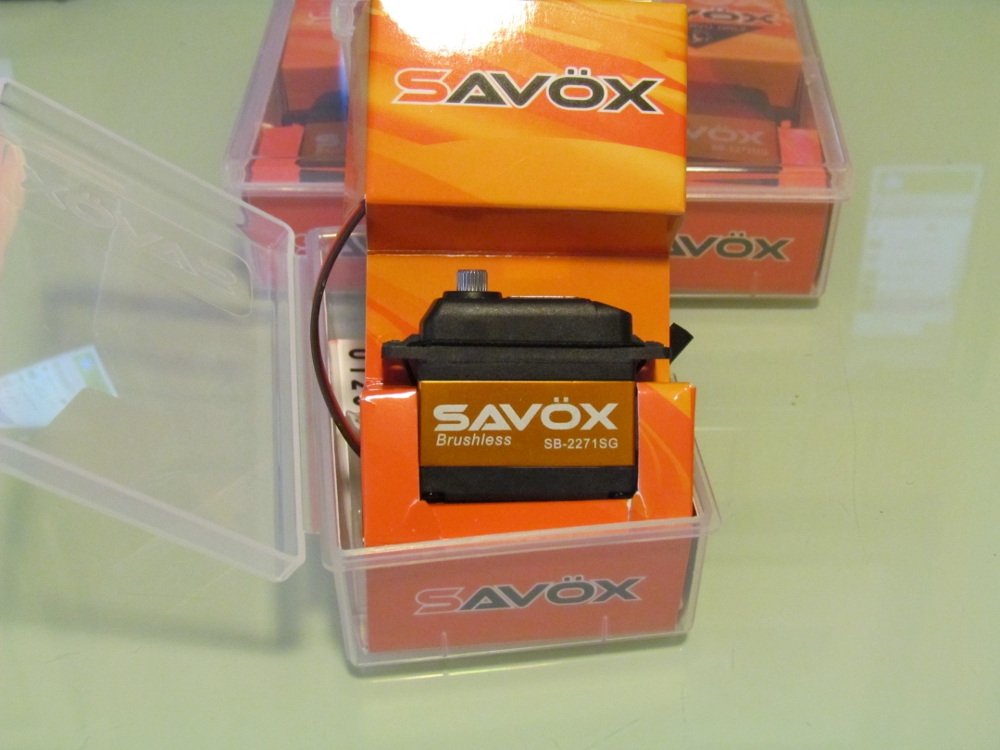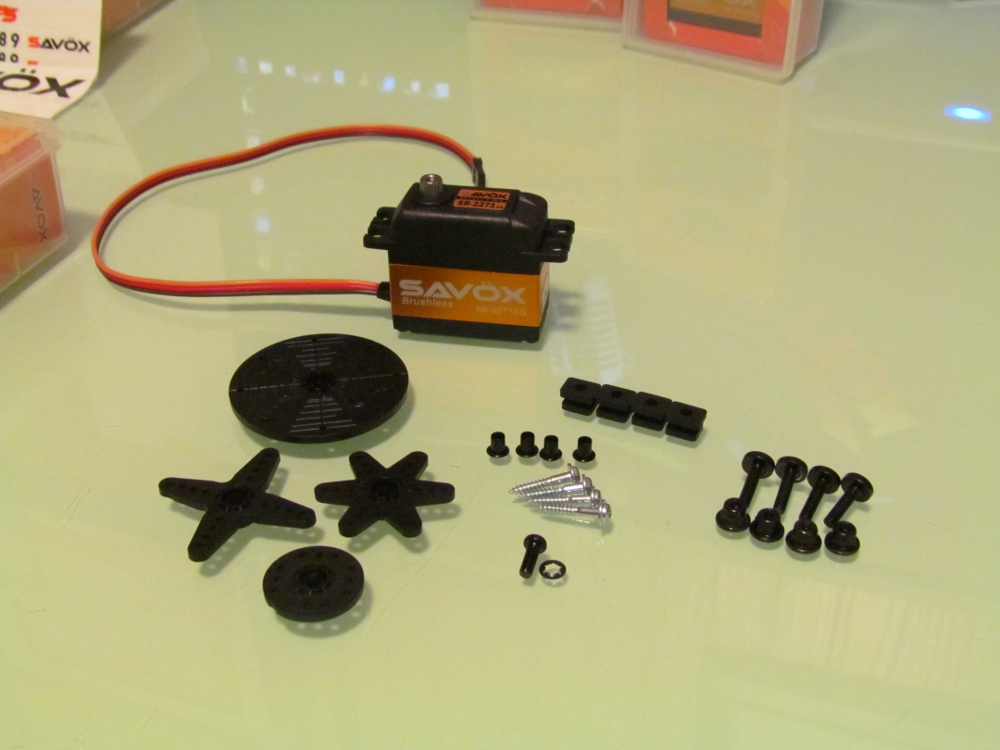I recently had to opportunity to spend some time with the Savox SB-2271SG and SB-2272MG brushless servos. Before I get into detail about the performance of the servos, I want to cover my initial impressions.
Savox SB-2271SGDimensions(mm): 40.3×20.2×38.5 |
Savox SB-2272MGDimensions(mm): 40.3×20.2×38.5 |

So what’s in the box other than the servo? I’m a big fan of the plastic box that Savox packages their servos in. I have been collecting them for some time; they just work great for storing small parts. Along with that you get the usual assortment of servo arms and hardware. Now the hardware is very nice, it includes the usual rubber grommet type mounting hardware and a horn screw with a lock washer. They also provide some bolts with lock nuts that are excellent. You also get a couple sticker sheets with the Savox logo and some numbers. The numbers are perfect for labeling what channel that specific servo is connected to, for easy reference later.
The servos themselves feel very robust and solid. The Gold anodized aluminum portion of the case really looks nice, with the laser etching. However only the center portion of the case is aluminum, both the top and bottom are a very durable composite plastic. The composite makes the mounting tabs very rigid. I was concerned about that initially, but they are very solid feeling.
Before any bench testing, I test fit the servo horns. They fit nice and snug, it will take a fair amount of force to get them to slip on the spline. In fact, I can say with certainty that the horns will break before they slip, but I will cover that later. With the servo horns on I moved the servos by hand from stop to stop several times. They are incredibly smooth with absolutely no binding, even at the stops.
For my testing I ran everything on an 8.46 volt source and an available 15 amps. Yes, this voltage is over the ratings that the servos are specified for, but I would rather push their limits on my bench than in the air. Being brushless my concerns were mostly heat, and how well would the case dissipate the heat. I ran the same test several times varying the time the servo ran from 5 to 6 minutes. Running the servo through its full limits non-stop for the full 6 minutes, I saw a maximum temperature of 120 degrees Fahrenheit. This temperature was also recorded with zero air flow and an ambient temperature of 70 degrees.
Happy with those results I got to work installing them in my SAB Goblin. The way they mount to the Goblin I did have to trim the center ridge off the mounting tabs to get them to mount flush. That composite plastic is tough! I went through at least 4 razorblades trimming them. I also decided to run them at 8.4 volts for the first few flights to see what temperature they would run with in flight air flow. After 20 flights with an average flight time of 8 minutes with an ambient temperature of 56 degrees (spring time in northern NY), the servos came in with an average temperature of 90 degrees. On average they seem to run about 30 degrees over the ambient temperature. They do fly very smooth and precise, it’s one of those things where you can just tell they are getting along very well with the flybarless unit. There will be updated reports in the future with more information when the weather is warmer.
I had hoped to have 25 flights on the servos before I put out this initial review. However, my 20th flight resulted in a forced auto with a blind landing. AKA, I crashed! So, bad news for my Goblin, but good news for this review. How do they hold up in a crash? In my opinion, very well. My crash had enough force to bend my blade grip linkage in two locations, so there had to be a pretty heavy load that the servos were fighting against to do that (take a look at the Goblin Head Links and you will see what I mean). The servos kept it together, they really did. The servo arms snapped off, but they did not slip on the spline. None of the gears skipped or stripped, they feel as smooth as they did the day I took them out of the box.
The price of these servos sits right around the mark of $130 each, depending on where you find them of course. That might seem like a lot, but considering the competition, you’re getting servos that rival the high end JR servos for nearly half the price.
All things considered I am very enthused with these servos, and I will continue to fly them at the 8.4 volts. The only thought I had for the future would be to see a full aluminum case, to further improve the heat dissipation. My next helicopter is certainly going to get another set of these!
Check back for more details, as I will be updating this review as I get more flights on these fantastic servos.
For more information and pricing visit
Find out more about me at JakeRC.com


